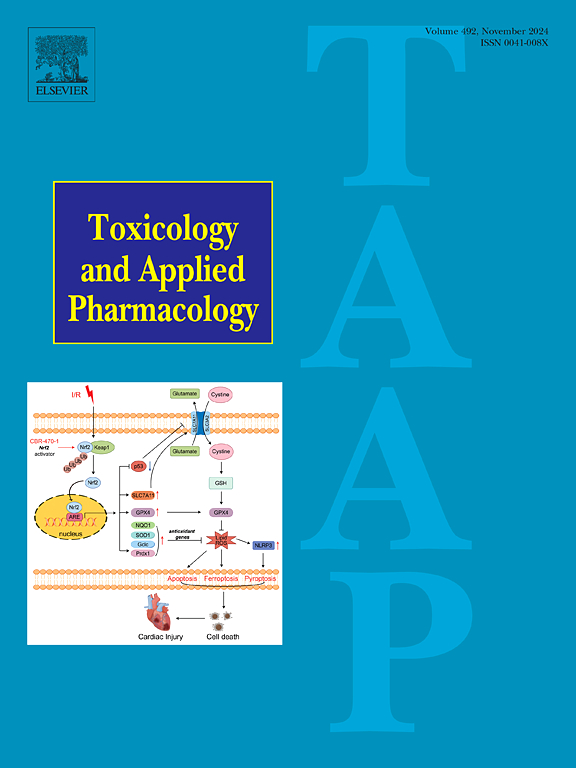Interactions between cadmium and 17β-estradiol at physiologically relevant levels evoke unsynchronized events in MCF-7 breast cancer cells: Impaired cell growth and activation of estrogen receptor α-related pathways
IF 3.3
3区 医学
Q2 PHARMACOLOGY & PHARMACY
引用次数: 0
Abstract
Cadmium (Cd), a heavy metal, is implicated in the development of estrogen receptor α (ERα)-positive breast cancers (BCs). However, controversy surrounds whether Cd is estrogenic or anti-estrogenic for the malignancy of in vivo animal models and human observational/epidemiological studies, a debate also presents in in vitro experiments. The development of ERα-positive BCs is stimulated by circulating 17β-estradiol (E2). Thus, potential biological interactions between E2 and Cd in the progression of ERα-positive BCs exist. Although the interactions between Cd and E2 at physiologically relevant levels (1 nM each) may not have been confirmed in vitro, it is likely to occur. Therefore, this study aims to investigate the interactions of chemicals in human BC MCF-7 cells (ERα-positive) using a sequential exposure system in which chemicals are added to cells every 24–48 h. Pretreatment with Cd, but not secondary treatment, interfered with E2-mediated oncogenic actions by inducing cell cycle arrest at the S phase. This was accompanied by changes in the expression of genes regulating the cell cycle checkpoint and upregulation of the tumor suppressor metallothionein 1F gene, which E2 suppressed. Paradoxically, ERα-mediated estrogenic pathways were upregulated. In conclusion, this study is the first to show that physiologically relevant levels of Cd may dampen E2-induced oncogenic events independent of the E2/ERα-mediated pathway.

镉和17β-雌二醇在生理相关水平上的相互作用在MCF-7乳腺癌细胞中引起不同步的事件:细胞生长受损和雌激素受体α相关途径的激活
镉(Cd)是一种重金属,与雌激素受体α (ERα)阳性乳腺癌(bc)的发展有关。然而,在体内动物模型和人类观察/流行病学研究中,Cd对恶性肿瘤是雌激素还是抗雌激素存在争议,在体外实验中也存在争议。循环中的17β-雌二醇(E2)可刺激er α-阳性bc的形成。因此,E2和Cd在er α阳性bc的发展过程中存在潜在的生物相互作用。虽然Cd和E2之间在生理相关水平(各1 nM)的相互作用可能尚未在体外得到证实,但它很可能发生。因此,本研究旨在研究化学物质在人BC MCF-7细胞(er α阳性)中的相互作用,采用顺序暴露系统,每24-48小时向细胞中添加化学物质。用Cd预处理,而不是二次处理,通过诱导细胞周期阻滞在S期,干扰e2介导的致癌作用。与此同时,调控细胞周期检查点的基因表达发生变化,E2抑制肿瘤抑制因子金属硫蛋白1F基因表达上调。矛盾的是,er α介导的雌激素通路上调。总之,本研究首次表明,与生理相关的Cd水平可能抑制E2诱导的致癌事件,而不依赖于E2/ er α介导的途径。
本文章由计算机程序翻译,如有差异,请以英文原文为准。
求助全文
约1分钟内获得全文
求助全文
来源期刊
CiteScore
6.80
自引率
2.60%
发文量
309
审稿时长
32 days
期刊介绍:
Toxicology and Applied Pharmacology publishes original scientific research of relevance to animals or humans pertaining to the action of chemicals, drugs, or chemically-defined natural products.
Regular articles address mechanistic approaches to physiological, pharmacologic, biochemical, cellular, or molecular understanding of toxicologic/pathologic lesions and to methods used to describe these responses. Safety Science articles address outstanding state-of-the-art preclinical and human translational characterization of drug and chemical safety employing cutting-edge science. Highly significant Regulatory Safety Science articles will also be considered in this category. Papers concerned with alternatives to the use of experimental animals are encouraged.
Short articles report on high impact studies of broad interest to readers of TAAP that would benefit from rapid publication. These articles should contain no more than a combined total of four figures and tables. Authors should include in their cover letter the justification for consideration of their manuscript as a short article.

 求助内容:
求助内容: 应助结果提醒方式:
应助结果提醒方式:


